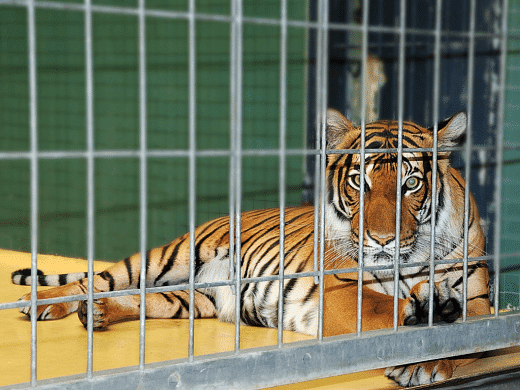A Tiger in the Zoo Summary Class 10 English First Flight Chapter 3
| Table of contents |

|
| Introduction |

|
| Freedom |

|
| Captivity |

|
| Contrasting Views: Freedom vs Captivity |

|
| Reflection and Conclusion |

|
Introduction
The poem written by Leslie Norris explains the agony and helplessness of a caged tiger that lives in a zoo. The poet explains what his life could be if he had been a free animal. The poet has tried to explain about the condition of animals that are caged by human beings for their own fun.
Freedom
The poem begins with a description of a tiger that is very beautiful and is walking in his little cage. He has beautiful stripes on his skin and has velvet like soft paws. But the tiger is unhappy and quite angry about being confined in the cage. The poet says that if the tiger was not confined to the zoo cage, he would have been hiding himself behind the long grass near some water body, in order to catch its prey that is the deer. Also, he would have terrorised the residents of the villages around the forest area. But the reality is totally opposite to this.

Captivity
He was confined in a cage which was made up of strong building material and he was helpless there. He could not show his power to the visitors, therefore, never tried to terrorize them. The tiger is described as being powerless and agonized by the poet. He says that during night also he is alone, hearing the voice of the patrolling vehicles of police and looking at the stars. The cage life has totally changed the tiger’s personality. The poet is trying to say that the animal which is famous for its fearlessness and freedom is confined and sad due to the human beings who want to derive pleasure by looking at him in the zoo cage.

Contrasting Views: Freedom vs Captivity
The inherent right of these majestic creatures to roam and express their instincts, prompting critical reflections on the ethical implications of captivity. While captivity ensures safety and conservation, it raises questions about the natural right to roam and express instincts. This nuanced perspective encourages a critical examination of the balance between preservation efforts and the inherent needs of these majestic creatures.
Reflection and Conclusion
The comparison between wild animals’ freedom and their lives in captivity is the theme of Leslie Norris’ poem “A Tiger at the Zoo.” The poem examines the feelings of loss and imprisonment that a tiger in a zoo experiences, as well as the contrast between the animal’s wild, untamed soul and the constrained life it is forced to live in captivity.
FAQs on A Tiger in the Zoo Summary Class 10 English First Flight Chapter 3
| 1. What is the central theme of the poem "A Tiger in the Zoo"? |  |
| 2. How does the poet depict the tiger's feelings in the poem? |  |
| 3. What is the significance of the tiger pacing up and down in the cage in the poem? |  |
| 4. How does the poet use irony in the poem to convey a deeper message? |  |
| 5. How does the poem "A Tiger in the Zoo" reflect on the human experience of freedom and captivity? |  |















